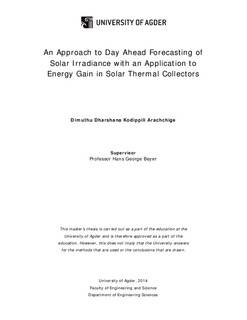| dc.description.abstract | Today, for the management of energy supply systems forecast information on load and theproduction of meteorology dependent (wind, solar, hydro) generation is ever rising. Solarirradiance forecasting is given a unique priority as it spans over major applications such asmanagement of grids with a high share of photovoltaic generation and thermal power supplysystems relying on solar heat generation. This thesis will address the day ahead prediction of thelocal irradiances intended to be applied for the management of solar assistant systems for heat andhot water supply. The forecast method presented here is based on the statistical analysis ofhistorical data in Kristiansand, Southern Norway. For this, satellite derived irradiance datacovering seven years provided by Geomodel Solar, Slovacia [11] can be used. In this approach, itis assumed that the irradiance sum of today shows a dependence on the irradiance sum of yesterday(Markov Assumption [26]). This day to day dependency is assessed by obtaining conditionalprobability distributions of irradiance sum on next day for a given status of weather, given here bythe irradiance sum on previous day. Based on such probabilistic approach two schemes areintroduced to obtain values for the forecasting. The first scheme is based on most probableexpected irradiance sum of tomorrow and the second approach is based on the average expectedirradiance sum, both extracted from the probability distributions. Having obtained forecastedvalues for the irradiance, the validity of prediction methods are investigated by comparing withthe actual measured data giving the statistical parameters, relative monthly Bias and relativemonthly Root Mean Square Error (RMSE). The approach using the average expected irradiancesum, gives more accurate results showing low RMSE. Concerning the application, the irradiancedata, both measured and forecasted are used to analyze the daily energy gain of a solar thermalcollector and its forecastability. These data are analyzed similar to the irradiance sets. The monthlyRMSE of the prediction of daily energy gain is investigated over a year. This shows that there aresignificant changes of forecast quality over the year with quite satisfactory behavior in summermonths with higher irradiances and thus higher gains, but however lower quality in the wintermonths with lower irradiance levels.Key words: Irradiance, Forecast, Energy, Day-ahead, Collector, RMSE | nb_NO |
